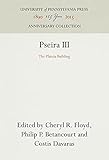Pseira III : The Plateia Building / ed. by Cheryl R. Floyd, Costis Davaras, Philip P. Betancourt.
Material type: TextSeries: University of Pennsylvania Museum of Archaeology and Anthropology ; 102Publisher: Philadelphia : University of Pennsylvania Press, [2015]Copyright date: 1999Description: 1 online resource (346 p.) : 114 illusContent type:
TextSeries: University of Pennsylvania Museum of Archaeology and Anthropology ; 102Publisher: Philadelphia : University of Pennsylvania Press, [2015]Copyright date: 1999Description: 1 online resource (346 p.) : 114 illusContent type: - 9780924171604
- 9781512819700
- 939/.18 21/eng/20230216
- online - DeGruyter
- Issued also in print.
| Item type | Current library | Call number | URL | Status | Notes | Barcode | |
|---|---|---|---|---|---|---|---|
 eBook
eBook
|
Biblioteca "Angelicum" Pont. Univ. S.Tommaso d'Aquino Nuvola online | online - DeGruyter (Browse shelf(Opens below)) | Online access | Not for loan (Accesso limitato) | Accesso per gli utenti autorizzati / Access for authorized users | (dgr)9781512819700 |
Browsing Biblioteca "Angelicum" Pont. Univ. S.Tommaso d'Aquino shelves, Shelving location: Nuvola online Close shelf browser (Hides shelf browser)

|

|

|

|

|

|

|
||
| online - DeGruyter A Musical View of the Universe : Kalapalo Myth and Ritual Performances / | online - DeGruyter Minoan Buildings in Areas B, C, D, and F / | online - DeGruyter Sotira : A Neolithic Settlement in Cyprus / | online - DeGruyter Pseira III : The Plateia Building / | online - DeGruyter The Archaeology of Martin's Hundred : Part 1, Interpretive Studies; Part 2, Artifact Catalog / | online - DeGruyter The Social Engagement of Social Science, a Tavistock Anthology, Volume 1 : The Socio-Psychological Perspective / | online - DeGruyter Denmark in World History : The External History of Denmark from the Stone Age to the Middle Ages / |
Frontmatter -- Contents -- List of Illustrations -- List of Figures -- List of Plates -- Preface -- Acknowledgments -- Abbreviations -- Part I Introduction -- Part II The Evidence -- Part III Discussion and Conclusions -- APPENDIX A Pottery Tables for the Plateia Building (Nos. 1-61) -- APPENDIX B Fabric Percentages (by Count) by Room/Space and Context -- APPENDIX C Average Percentages of Sherds (by Count) in Various Fabrics According to Contexts -- APPENDIX D Percentages of Sherds (by Count) in Various Fabrics According to Vessel Types -- APPENDIX E Percentages of Sherds (by Count) of Various Vessel Types -- APPENDIX F List of Stone Tools by Context and Rooms -- Bibliographical References -- CONCORDANCE A Field Numbers and Numbers in This Volume -- CONCORDANCE B Excavated Units and Room/Space Numbers for the Plateia Building and Vicinity -- Index -- Figures -- Plates
restricted access online access with authorization star
http://purl.org/coar/access_right/c_16ec
The Pseira project began in 1985. Excavations were conducted from 1986 to 1991 as an American-Greek collaboration directed by Philip P. Betancourt and Costis Davaras. The Plateia Building (Building BS/BV) is located at the north of the Town Square or Plateia. It occupies the entire northern side of the square, with one room built on the eastern side as well. The structure is the largest building excavated at Pseira. The building was discovered by small tests made in 1986, and it was excavated in subsequent seasons. From the beginning, the building was recognized as an important structure in the town. Its excavation was conducted slowly and meticulously, with careful attention to the proper recovery and recording of its data.University Museum Monograph, 102
Issued also in print.
Mode of access: Internet via World Wide Web.
In English.
Description based on online resource; title from PDF title page (publisher's Web site, viewed 26. Aug 2024)


